
Recent tests by a building science research firm have backed up anecdotal evidence that at least some brands of oriented strand board (OSB) sheathing are too leaky to be considered effective air barriers.
The work was carried out by RDH Building Science Inc., a research and consulting company. The results were shared in a mid-August podcast led by Jonathan Smegal, a senior project manager at RDH.
Smegal and his colleagues tested samples of OSB, plywood, and the popular coated OSB sheathing made by Huber—Zip System—to determine whether the materials could technically be considered air barriers. Can builders and designers rely on these materials as an air control layer that would allow the house to meet Passive House–level airtightness standards?
At least in the case of OSB, the answer is probably not.
Smegal starts the hour-long podcast by emphasizing the importance of making buildings airtight for better health, greater durability, and lower energy use. Although leaky building enclosures historically have been a concern in cold climates, he said, air leaks also cause a variety of problems in warm, humid climates.
Designers use a variety of materials to make buildings airtight, including flashing tapes, membranes, and sheet goods like plywood and OSB, a common engineered-wood product made from wood chips formed into panels and bonded with glue. Smegal noted that OSB at least 3/8 in. thick is considered an effective air barrier by ASHRAE, the International Energy Conservation Code (IECC), and The Engineered Wood Association (APA). In a follow-up telephone call, Smegal said the reading he did suggested that, at some point in the past, permeance tests had been conducted on OSB. But he was unable find any data on air permeance from OSB manufacturers themselves.
“It looks to me like the OSB manufacturers are not advertising their own products as air barriers,” he said, “but all the codes are pointing out that you need a minimum 3/8-in. OSB board in order to meet the air barrier requirement.”
In other words, even though OSB makers weren’t making any claims about air permeance, a lot of people have been assuming that it could be part of an airtight assembly.
But doubts have been accumulating. In the podcast, Smegal cited articles that appeared at Green Building Advisor and The Journal of Light Construction, suggesting that builders had relied on an industry assumption that OSB could be used as an air barrier before discovering that was not the case.
Some of these early problems were reported in the 2014 GBA article “Is OSB Airtight?” A U.S. architect and an Irish engineer had reported problems with buildings that had been sheathed with OSB, while Belgian researchers in 2010 found that some European brands of OSB could not meet a standard air-barrier test.
At the behest of Huber, which manufacturers Zip products, RDH set out to check on these reports through controlled tests in a lab.
How the tests were carried out
Initially, the study was designed to measure the air permeance of three types of sheathing: 15/32-in. plywood, 7/16-in. OSB, and 7/16-in. Zip. Phase 1 of the project was to measure permeance and find out what effect wetting and drying cycles would have on them. They used a standard testing method (ASTM E2178) to check air-leakage rates under pressures that ranged from 25 to 300 Pascals (Pa).
What constitutes an air barrier? For purposes of this study, RDH used a standard criteria of 0.02 liters per second per square meter at 75 Pascals of pressure (lps/m2). If a material allows more air than that to get through, it’s not effective as an air barrier.
After measuring the permeance of the sheathing materials alone in Phase 1, some of the same samples were then used to build subassemblies for further testing. These samples consisted of OSB and plywood sheathing covered by housewrap, as well as samples of Zip sheathing with no additional air and water barrier.
In the final phase of testing, researchers nailed vinyl siding onto the samples to see how that affected airtightness.
What the tests found
Test results were a boon for Huber and a disappointment for the two OSB manufacturers, which Smegal did not identify. Zip samples passed with flying colors, showing extremely low air leakage even after samples had been repeatedly soaked in water and dried out. None of the OSB samples could meet the air-barrier standard, and plywood did so with a dry sample but not after the sample had gone through wetting and drying cycles.
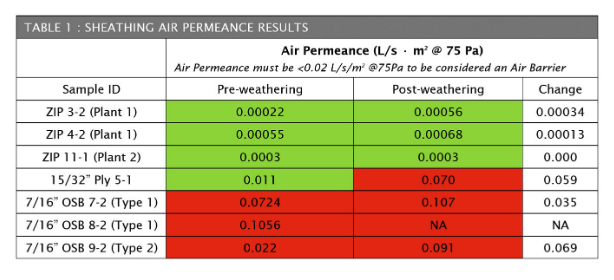
In Phase 2, samples that had gone through weathering in Phase 1 were tested a second time as part of a subassembly—that is, nailed to studs. The test samples looked like miniature wall assemblies. Researchers followed manufacturer recommendations and building codes and treated samples identically. The plywood and OSB samples got a layer of Tyvek housewrap; the Zip sample was simply taped at the seams with Zip tape.
Results? The sheathing and air barrier subassemblies with housewrap all met the air barrier minimum handily under both negative and positive pressure.
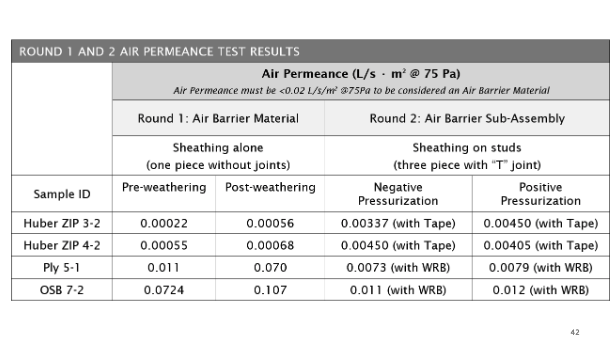
Phase 3 of testing was aimed at finding out what happens when vinyl siding is added. Three pieces of siding were nailed on, one at a time with measurements at each stage, with a mix of nails—some that successfully hit the studs and some that did not. With both negative and positive pressurization, plywood samples with a water-resistive barrier were too leaky to be considered an air barrier, even when all the nails hit the studs. Air leakage in the Zip samples far exceeded the standard.
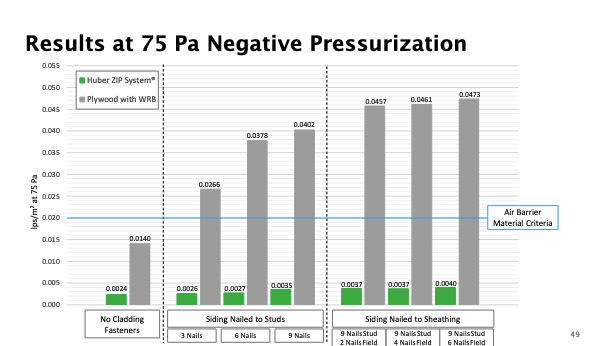
When a nail that had missed a stud was removed, a 1/8-in. hole remained. That pushed air leakage rates up significantly.
What this means for builders
The message for designers and builders who are striving for airtight construction seems clear: OSB by itself is not a reliable air barrier, even if seams in the sheathing are sealed with flashing tape. Plywood seems to work better, but not if it’s gone through a number of wet-and-dry cycles, as it might on a job site.
When siding is nailed onto sheathing that’s been covered with a WRB, expect lots of air leaks.
“It definitely becomes a lot more air-leaky,” Smegal said. “You’re puncturing the air barrier, and it comes down to sealability around those punctures, because you can’t build a wall in most cases without putting some penetrations through the air barrier.”
However, Smegal said that even when a single building component—in this case, sheathing—does not meet the 0.02 lps/m2 criteria, a house can still be reasonably airtight—just not airtight enough to get to the 0.6-ACH50 level required by Passive House.
“It doesn’t meet the material air-barrier requirement anymore, but would it still be a reasonable-level air barrier?” Smegal asked. “Once it’s assembled it might. Would it meet the Passive House requirement? No. I think we’re clear that using OSB and Tyvek or any housewrap as an air barrier on a Passive House and then penetrating it full of fasteners would not meet the air barrier requirement of 0.6. But would it meet a reasonable airtightness on a house? It definitely could and it has in many cases. It just comes down to the details.”
Without doing some calculations, Smegal said it was a guess as to how airtight that very common assembly would actually be. But, he said, it would probably be hard to get the house down to 1 or 1.5 ACH50.
Asked what the main takeaway from the study might be for a builder, Smegal said, “If I wanted to build a really airtight building, then I would be choosing between some of the higher-performance options, such as taped sheathing or self-adhered membranes, those types of things. I wouldn’t rely on OSB. I’d probably use plywood instead of OSB if I wanted to use a taped standard wood sheathing or I’d go to a Zip-type product or a self-adhered membrane as an air and water barrier.”
Richard Pedranti, the architect who helped get the ball rolling with his failed blower-door test, would agree. Reached by telephone after the podcast had aired, Pedranti said his 2015 project was instructive.
“We stopped using OSB as a designated air barrier after our experience,” he said. “There’s no gray area there. It’s either Zip, plywood, or a membrane.”
That house was Pedranti’s first attempt at getting a very tight envelope, his first Passive House. He had talked with colleagues and leaned heavily on the Passive House building community for advice. He went with OSB. After a frustrating several hours of trying to track down the source of air leaks during the blower-door test on a sweltering summer day, Pedranti’s building science consultant suggested the problem might be the OSB itself. “No way,” Pedranti remembers saying, but the test with the plastic film captured in the photo above proved the consultant right.
“We had a low budget for the house,” he said. “OSB seemed like the obvious choice. Not in a million years did I think we would have a problem with OSB.” The solution for him was a membrane made by Siga, which he applied over the OSB. That worked.
More testing may be on the horizon
The sample size in the RDH study was very small—only a single plywood entry and only two for OSB. According to the industry consultant group Forisk, there are 10 OSB manufacturers in North America, and that leaves plenty of potential variation in panel composition.
Smegal said RDH has been invited to present its work on this topic next year at a conference in Toronto, and in advance of writing the report would hope to do some additional testing.
Should manufacturers be doing more testing themselves? “It would be helpful to know,” Smegal said, “but because they’re not marketing it as an air barrier, they really don’t have the responsibility to test it.”
Scott Gibson is a contributing writer at Green Building Advisor and Fine Homebuilding magazine.
Weekly Newsletter
Get building science and energy efficiency advice, plus special offers, in your inbox.





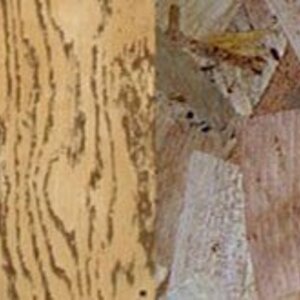
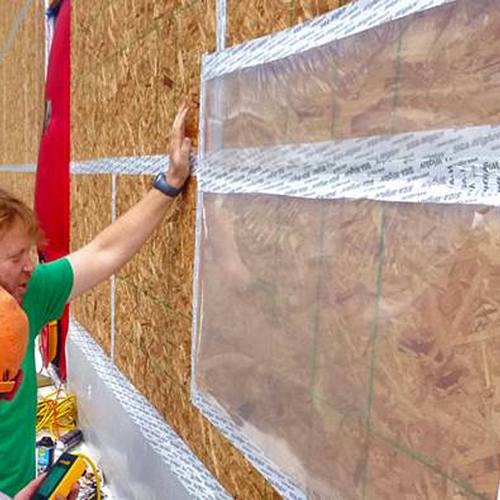
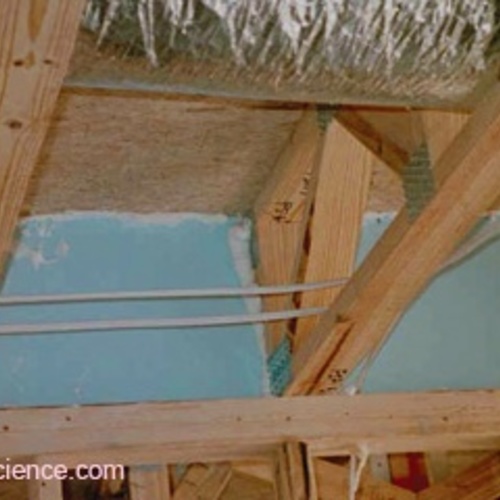







32 Comments
This is a great start into this! But I also question the value of the 75pa in the real world. (Or even 50!) While that may be good for differentiating air permeability of these dense materials...... does it actually matter? Does plywood with siding leak at 75 pa, but effectively not at all in a real situation, or say at 25 pa? I'm curious about how they chose the line in the sand for "air barrier" permeability.
Hopefully more testing and data in the future will help the building science community figure this out.
If these products are this bad under these conditions, one can only cringe at the
thought of nailing a couple inches of foam over the top and then going through
the hassle of trying to attach siding and trim over the foam.
The thing is that these products other than OSB really aren't bad. Passive House should not be a goal for every house.
Forrest, no need to cringe, just educate yourself on the proper techniques. Lot's of resources available and foam over-sheathing is an effective strategy on many fronts.
My house with 7/16 OSB air barrier achieved 0.22ACH50, and all the other houses by the same builder got similar numbers. So the statement "would probably be hard to get the house down to 1 or 1.5 ACH50" is a little suspect. Now, these examples are with interior sheathing, so maybe they should differentiate and maybe that will be in the next round of testing.
You had no membrane over it? Just taped the OSB?
I think there's enough low-hanging fruit that most builder's concerns should be focused elsewhere than the permeability of their sheething, which would be in the noise of most buildings tested. For a builder who's targeting below 1 ACH50, maybe.
If PH is the goal, chances are a standard OSB air barrier is not in the plans. :)
> {third RDH table} Plywood sheathing covered with housewrap ... vinyl siding
Isn't this an assembly (vs a material) that easily meets Joe L's 0.20 l/(s-m2)@75 Pa for an air barrier assembly?
A fully adhered membrane should be in the test results and "Plywood sheathing covered with housewrap could not be considered an air barrier" should be more like "The tested plywood, non-fully-adhered house wrap and vinyl siding assembly could not be considered an air barrier when misusing the material specification"
> At the behest of Huber, which manufacturers Zip products, RDH ...
Who paid for this study?
+1 on all of Jon R's comments.
Re: the WRB, self Adhered WRB for the OSB and Ply would have been a more level playing field vs ZIP.
IMO the big question over ZIP vs liquid applied WRB is how the barrier performs over time. Specifically years of contraction/expansion and settling.
Martin had an article on this very subject in 2014 (with the same picture)
https://www.greenbuildingadvisor.com/article/is-osb-airtight
Alex,
There is a link to it in the article above..
Oh didn't see it. Sorry :-)
Alex,
You are in Quebec aren't you? Have the materials prices come down there since the summer highs?
Yes quite a bit! I saw some 2x4x8 at 2.99$ last week but they are still 4$ at HD. They were selling them 10$ this summer so it's much better than it was.
OSB is still a bit expensive though, twice the price it was before Covid. I can get a 4 x 8 x 19/32 sheet for around 35$ to give you an idea.
Engineered wood products and TJI are still expensive as well. A 9.5''x16' ijoist was 26$ before covid and now it's 63$. At least you can get them now...
Other, than that I think everything is around 10% more expensive than it was before Covid.
Same in BC?
Prices are down here but not uniformly - almost randomly - although maybe if I knew more about the supply chains be it would make m0re sense.
I'd say overall they are down en0ugh that people aren't making building decisions with material prices as the foremost consideration.
Stepping back bit - while this may be important to builders hoping to use these products as their primary air-barrier (although to echo Nate's post, it may only meaningfully impact those looking for extremely low ACH results), these products were developed as structural sheathing. It's no knock on them that they don't perform a function others have decided to use them for.
I would like to see the results after Aerobarrier is used.
I would expect it would have no problem sealing any of this leakage. I think you could use a window screen as an air control layer and Aerobarrier would seal it.
Charlie,
I wonder what Aerobarrier would do to the perm rating of something like OSB that had to be sealed across its entire surface, as opposed to just a few cracks?
That's a really interesting question! That could be a problem for a material that already has lower permeability that we might like.
If you have to just fill up some cracks, would a paint not do the trick? From inside while the sheating is accesible or outside if you have a wrb or external insulation ?
Mind that you do not need a 100% job in this case
It would be great to have the details of weathering and/or wetting. For example, were the panels wet in a manner to simulate sheathing being exposed to rain after having been attached to vertical studs? Or were the panels wet in a horizontal plane position that is more like subflooring taking a soaking, for example? Did the wetting cycles occur before or after WRB was applied?
Call me a skeptic here, but there's a lot to be desired in this whole setup.
1. If you're going to test ZIP against a competitor, lay it out there. You'd better be telling me who you're better than, so that I can go buy a sheet of their osb and test it myself. Take a note from Banks, grab the hair on your chest and stir the pot :). Otherwise a manufacturer can't come out and say hey, no dice. Here's our test data that shows otherwise! This gives nobody the opportunity to rebut their claims. The results are too good (bad?) to be believed. Besides, per dollar, they should have tested it against 5/8" or 19/32" osb. It's not the thickness that counts per se, rather the cost per square ft of material, installed.
2. I didn't read the study, but if the airworthiness of osb is questionable, then why tape a giant section of plastic over seams that are taped, and may have other sources of leakage? In that picture, it's impossible to say wether or not it's the osb that is leaking air, or if it's coming from any of the seams where the tape can bridge the very small gap due to the roughness in the surface of the osb. There are nail penetrations there as well, even as mentioned in the article. Surely a cubic foot box test or so with an air chuck and pressure gauge would have been a more definitive "Is this material leaking" test. Do we need to find a better material, or a better way to seal the penetrations in that material? I'd point to the latter.
There are plenty of homes built with osb that are < 1 ACH50. This feels like an invisible boogeyman that's sponsored by Huber.
Not that I don't like Huber, they make great products. This test just leaves too much to the imagination for me to slam a fist on the table and proclaim "That's it boys, it's zip or nothing from here on out."
Kyle,
It seems to be a common tactic. This one is purported to be a comparison between Tyvek and Zip. https://www.youtube.com/watch?v=p3q09-Thebs
That said, RDH does excellent work. I'm not sure they can be tarred with the same brush.
Malcom,
I agree. I've generally been impressed with RDH, that's why I was a little taken at the whole thing. Someone at RDH knows better.
Kyle,
"There are plenty of homes built with osb that are < 1 ACH50.".
As we know from the ones that have featured in GBA blogs. I think this whole issue needs to play out more.
> why tape a giant section of plastic over seams that are taped ...
Good point - include the taped seams and I'd call it an assembly, not a material.
> roughness in the surface of the osb
Was primer before the tape used in all of the OSB tests? It's recommended for a rough surface.
It's my understanding the photo was from the field build that initially prompted the study, and that photo doesn't depict the actual procedure used. But the same thought occurred to me, if the poly is billowing out over a taped seam, the seam is the culprit.
They're also toxic waste dumps. But that's not really a concern of "passive house" proponents.
I think the article needs to be clear, this study *was sponsored* by Huber. “Behest” leaves much room for interpretation.
And with ZIP, only the WRB side was exposed to the wetting cycles? That definitely doesn’t replicate job site conditions. It’s just apples and oranges at that point. Why not wet both sides of all of them? Or why not apply a self-adhered WRB to plywood and OSB?
"For purposes of this study, RDH used a standard criteria of 0.02 liters per second per square meter at 75 Pascals of pressure (lps/m2). If a material allows more air than that to get through, it’s not effective as an air barrier."
OK, so 0.02 L / s / m2 @ 75 Pa is equal to 0.00006562 cuft / s / sqft @ 75 Pa
Using a 2 story house 40'L x 20'W x 20'T we have 2,400 sqft of exterior wall sheathing and 16,000 cuft of interior volume. Using the RDH air barrier criteria:
(0.00006562 cuft / s / sqft) x (2400 sqft) x (60 s / min) = 9.45 cfm @ 75 Pa
9.45 cfm / 16,000 ft3 x 60 min/hr = 0.035 ACH75
To convert from ACH75 to ACH50 I'm using a conversion factor of 0.73, right in the middle of the 0.67 - 0.80 factor calculated in this white paper:
https://www.phius.org/Tools-Resources/TechCorner/201508-Airtightness-Karagiozis.pdf
0.035 ACH75 x 0.73 = 0.o25 ACH50
For the record, this means the RDH considers a wall sheathing material ineffective as an air barrier if it contributes more than 4% of the total air leakage on a 0.6 ACH50 Passive House build, or 2.5% on a 1.0 ACH50 Pretty Good House build. That seems ludicrous to me!
What does "For purposes of this study" mean? I read that as saying they chose a specific criteria for this study, rather than saying something sensible like "We chose X because it meets standard Y". Is it a coincidence that the 0.02L spec is just tight enough that all three OSB samples fail, one by only 0.002L?
Also, they keep referring to Passive House as the standard to meet. Who uses OSB as the main air barrier on a Passive House build and then plans to nail vinyl siding through it? I doubt a PH consultant would even approve that practice.
This whole test smells like BS to me. Someone please tell me I'm being unreasonable, or just plain wrong!?!
Log in or create an account to post a comment.
Sign up Log in